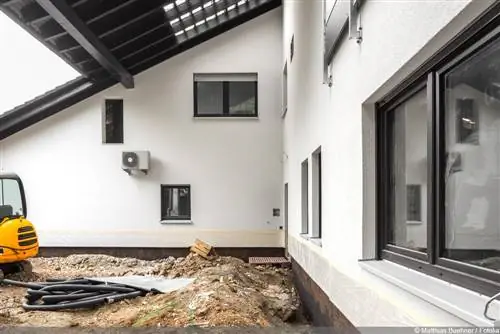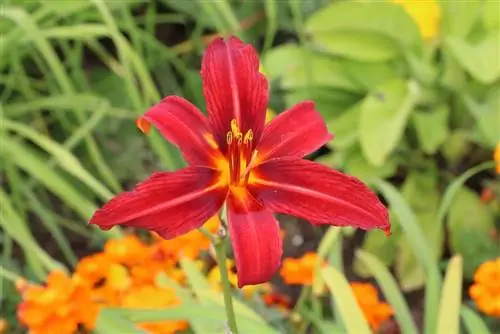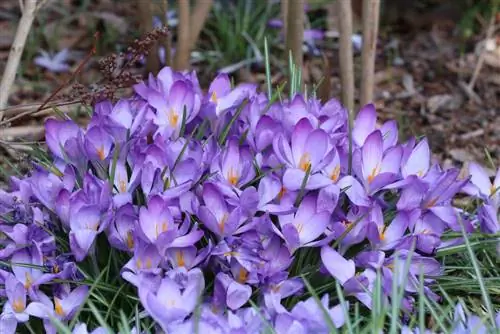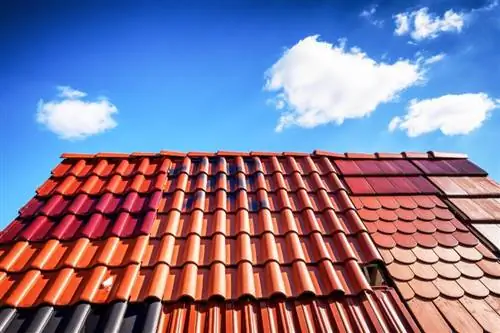- Author admin [email protected].
- Public 2023-12-17 03:39.
- Last modified 2025-01-24 12:45.
Various materials are suitable as base colors. Above all, these are very weather-resistant, as the base of a facade or wall is exposed to many weather influences. A hard-wearing, abrasion- and abrasion-resistant and water-repellent paint should be used here. It is also important that the color combination matches the rest of the facade. Everything about colors, materials and costs is explained in the following article.
Why special base color?
Especially the base of a facade or wall, i.e. the lower area that is directly connected to the ground, must be very weather-resistant. In heavy rain, for example, the drops bounce off the ground and reach the lower area of a facade. When it snows, the fallen snow can also lie tightly against the lower part of the house wall. The base color must above all be frost-resistant, water-repellent but also heat-resistant, for example if this is the south side of the facade. Even houses that are located directly on a busy street and so the base gets a lot of splash water are better protected by a darker base color.
Plaster for the base
If it is a new building, the base is usually plastered. It is possible to color the plaster in a desired color so that the base also matches the rest of the house. Either the same color can be used here, but the base can also be highlighted with a different tone, although care should be taken to ensure that the color harmonizes with the rest of the facade and that they come from the same color family. The plaster for the base is used as follows:
- Mineral plaster as a substrate
- additionally colored finish plaster
- Use color powder
- is lightfast and UV-resistant
- Use silicone or silicate resin plaster
- can also be colored
- Use synthetic resin plaster
- also suitable for coloring
If you don't want to go to the trouble of coloring the plaster used yourself and also want to add colorful accents to the base, you can choose colored stone plaster.
Tip:
Each plaster works well with a different color powder. Therefore, you should choose the appropriate color when purchasing the plaster.
Materials for base colors

If the house is older and the facade needs to be painted, then the applied plaster is usually painted over. In such a case, a specific color mixture is also used for the base. The base colors are therefore usually colors that must have the following properties for outdoor use:
- highly weather-resistant
- water-repellent
- UV-resistant
- frost resistant
- breathable
- Diffusion ability on the substrate must be maintained
- Resistance to aggressive environmental influences
- for example acid rain
- other air pollution
Dirt, algae and green deposits can no longer settle as easily with the corresponding base colors because the water can run off on the smooth undersurface. These properties are particularly important for water-thinnable emulsion paints, which are used for the colorful design of heavily used wall surfaces outdoors and indoors. Emulsion paints are suitable for all common interior and exterior plasters, brickwork, concrete, sand-lime brick and cement.
Tip:
For outdoor areas, you should choose a paint that has high color stability and opacity, is solvent-free, breathable and odorless and, above all, easy to work with.
Colors
The shades for the base color can be selected according to your own taste. But the location of the house where the base is to be repainted also plays a major role. The color chosen should also match the rest of the facade. This is particularly successful if tones from the same color family are chosen. When choosing the color, the location where the house was built is particularly important. If the facade is surrounded by a garden, then lighter tones can also be chosen. If the front of the house is located directly on a busy street, it makes more sense to choose the colors in dark tones. These can then also differ from the rest of the facade. The following colors are often chosen for the base:
- Havana
- Sandstone
- Slate
- Gray
- Anthracite
- Dark gray to black
Bright colors can quickly make a house look cheap and silly. Therefore, muted tones for the base and the entire facade are more recommended. If you rely on different tones between the base and the facade, you can also use the tone of the base in accents on the facade, for example around the windows. This creates a harmonious connection between the base and the facade.
Tip:
Especially on a busy street, the smallest particles of dirt and water are catapulted from the tires of fast-moving cars against the base of the house. Therefore, in such a case, a dark base color makes more sense.
Costs
The costs for the base colors are usually no higher than those for the color of the facade. Because this is an emulsion paint. The color is available at your local hardware store or in various online shops. Since the requirements for the roof and base of a house are relatively the same, combination colors are often offered that can be used equally for the base as well as for a roof. The costs for the base colors are usually as follows:
- per liter between 6.40 euros and 6.60 euros
- five liter buckets are usually offered
- Prices between 31.99 euros and 32.99 euros
Of course there are also providers who offer the base color cheaper or more expensive. Here you can start a price comparison online before purchasing and look at the ratings for the different colors on offer. Because the most expensive color does not necessarily have to be the best in quality. Therefore the comparison is worthwhile here too.






